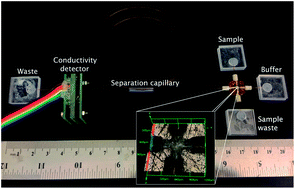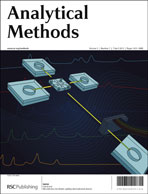Microfab-less microfluidic capillary electrophoresis devices†
Abstract
Compared to conventional benchtop instruments, microfluidic devices possess advantageous characteristics including great portability potential, reduced analysis time (minutes), and relatively inexpensive production, putting them on the forefront of modern analytical chemistry. Fabrication of these devices, however, often involves polymeric materials with less-than-ideal surface properties, specific instrumentation, and cumbersome fabrication procedures. In order to overcome such drawbacks, a new hybrid platform is proposed. The platform is centered on the use of 5 interconnecting microfluidic components that serve as either the injector or reservoirs. These plastic units are interconnected using standard capillary tubing, enabling in-channel detection by a wide variety of standard techniques, including capacitively coupled contactless conductivity detection (C4D). Due to the minimum impact on the separation efficiency, the plastic microfluidic components used for the experiments discussed herein were fabricated using an inexpensive engraving tool and standard Plexiglas. The presented approach (named 52-platform) offers a previously unseen versatility, enabling the assembly of the platform within minutes using capillary tubing that differs in length, diameter, or material. The advantages of the proposed design are demonstrated by performing the analysis of


 Please wait while we load your content...
Please wait while we load your content...